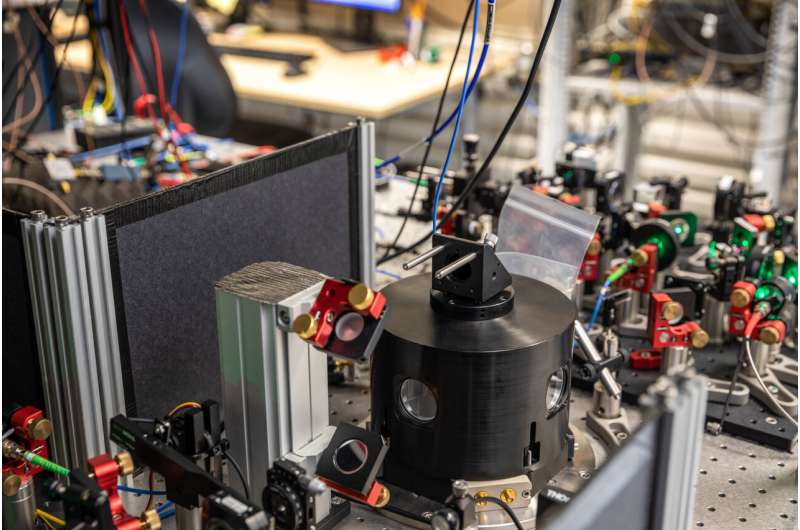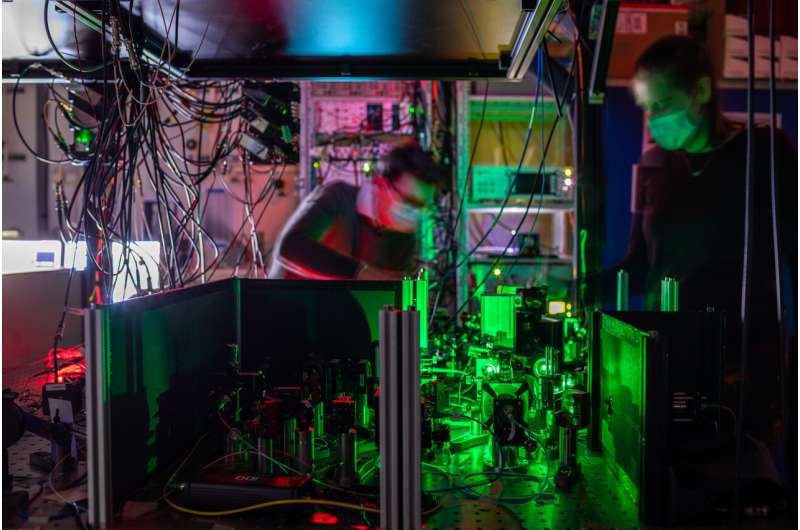Researchers teleport quantum information across rudimentary quantum network

Researchers in Delft have succeeded in teleporting quantum information across a rudimentary network. This first of its kind is an important step towards a future quantum internet. This breakthrough was made possible by a greatly improved quantum memory and enhanced quality of the quantum links between the three nodes of the network. The researchers, working at QuTech—a collaboration between Delft University of Technology and the Netherlands Organization for Applied Scientific Research (TNO)—are publishing their findings today in the scientific journal Nature.
The power of a future quantum internet is based on the ability to send quantum information (quantum bits) between the nodes of the network. This will enable all kinds of applications such as securely sharing confidential information, linking several quantum computers together to increase their computing capability, and the use of highly precise, linked quantum sensors.
Sending quantum information
The nodes of such a quantum network consist of small quantum processors. Sending quantum information between these processors is no easy feat. One possibility is to send quantum bits using light particles, but due to the inevitable losses in glass fiber cables, in particular over long distances, the light particles will very likely not reach their destination. As it is fundamentally impossible to simply copy quantum bits, the loss of a light particle means that the quantum information is irrecoverably lost.
Teleportation offers a better way of sending quantum information. The protocol for quantum teleportation owes its name to similarities with teleportation in science-fiction films: The quantum bit disappears on the side of the sender and appears on the side of the receiver. As the quantum bit therefore does not need to travel across the intervening space, there is no chance that it will be lost. This makes quantum teleportation an crucial technique for a future quantum internet.
Good control over the system
In order to be able to teleport quantum bits, several ingredients are required: a quantum entangled link between the sender and receiver, a reliable method for reading out quantum processors, and the capacity to temporarily store quantum bits. Previous research at QuTech demonstrated that it is possible to teleport quantum bits between two adjacent nodes. The researchers at QuTech have now shown for the first time that they can meet the package of requirements and have demonstrated teleportation between non-adjacent nodes; in other words over a network. They teleported quantum bits from node "Charlie" to node "Alice," with the help of an intermediate node, "Bob."
Teleporting in three steps
The teleportation consists of three steps. First, the "teleporter" has to be prepared, which means that an entangled state must be created between Alice and Charlie. Alice and Charlie have no direct physical connection, but they are both directly connected to Bob. For this, Alice and Bob create an entangled state between their processors. Bob then stores his part of the entangled state. Next, Bob creates an entangled state with Charlie. A quantum mechanical "sleight of hand" is then performed: By carrying out a special measurement in his processor, Bob sends the entanglement on as it were. Results: Alice and Charlie are now entangled, and the teleporter is ready to be used.
The second step is creating the "message"—the quantum bit—to be teleported. This can, for example, be "1" or "0" or various other intermediate quantum values. Charlie prepares this quantum information. To show that the teleportation works generically, the researchers repeated the entire experiment for various quantum bit values.

Step three is the actual teleportation from Charlie to Alice. For that purpose, Charlie carries out a joint measurement with the message on his quantum processor and on his half of the entangled state (Alice has the other half). What then happens is something that is possible only in the quantum world: As a result of this measurement, the information disappears on Charlie's side and immediately appears on Alice's side.
You might think that everything is then completed, but nothing could be further from the truth. In fact, the quantum bit has been encrypted upon transfer; the key is determined by Charlie's measurement result. So Charlie sends the measurement result to Alice, after which Alice carries out the relevant quantum operation for decrypting the quantum bit. For example via a "bit flip": 0 becomes 1 and 1 becomes 0. After Alice has carried out the correct operation, the quantum information is suitable for further use. The teleportation has succeeded.
Teleporting several times
Follow-up research will focus on reversing steps one and two of the teleportation protocol. This means first creating (or receiving) the quantum bit to be teleported and only then preparing the teleporter for carrying out the teleportation. Reversing the order is particularly challenging as the quantum information to be teleported must be stored while the entanglement is being created. However, it comes with a significant advantage as the teleportation can then be carried out completely "on request." This is relevant, for example, if the quantum information contains the result of a difficult calculation or if teleportation must be done multiple times. In the long run, this type of teleportation will therefore serve as the backbone of the quantum internet.
More information: S. L. N. Hermans et al, Qubit teleportation between non-neighbouring nodes in a quantum network, Nature (2022). DOI: 10.1038/s41586-022-04697-y





















